
Vampire GOLD2 Core Released for V600 v2 & V500 v2.
Changelog:
- AMMX greatly improved.
- Added CPU counters.
- Added TURTLE mode.
- Modified PCR register. 68080 now acts as a 060.
- Modified MOVEC Rc,Rn (reads in User mode and Writes in Supervisor mode)
- Improved some loops patterns.
- Improved self-modifying code support.
- Improved memory controller to be full 32-bit.
- Improved HDMI core.
Also, SAGA Driver package has been updated to v0.11 to accomodate new things.
Download: Vampire Core & Saga Driver (1461)
source: apollo-accelerators.com
 The HxC Floppy Drive Emulator is a software and hardware system created by jfdn aka Jeff.
The HxC Floppy Drive Emulator is a software and hardware system created by jfdn aka Jeff.
The aim of this project is to replace the floppy disk drive by an electronic device emulating the floppy disk drive (list of supported Computer/Hardware).
There are two differents emulators:
- A USB version which allows to connect the floppy disk drive interface of the computer to a PC via a USB cable.
- A SDCARD version which allows to emulate floppy disks which images are stored in a SDCARD.
Release notes for the HxCFloppyEmulator software v2.1.6.0:
- XML format definitions : Korg DSS1 DD disks added.
- XML format definitions : Emax II disks added.
- Command line tool : USB loader -> Raw loader added.
- Amstrad DSK file added to the batch converter export list.
- New Writer : Thomson *.FD writer.
- Thomson *.FD loader fixed : Side 1 ID corrected to 0.
- D88 Writer fixed : Cylinder and Side ID correctly set.
- ImageDisk (*.IMD) export : Deleted data mark and data CRC error flags supported.
- FAT12/16 Disk browser : Entries First cluster readback corrected. (With high word uninitialized).
- IMG loader : More disk sizes support added.
- DosDiskBrowser : 1.743MB & 1.764MB added.
- 64bits systems : Batch converter and Dos Disk browser issues fixed.
- MacOS X & Linux version : file export -> Auto-append the file extension.
- Track editor : Disk flux stream reverse function.
- Track viewer & editor : GUI layout changed/updated.
Download:
source: hxc2001.free.fr lotharek.pl
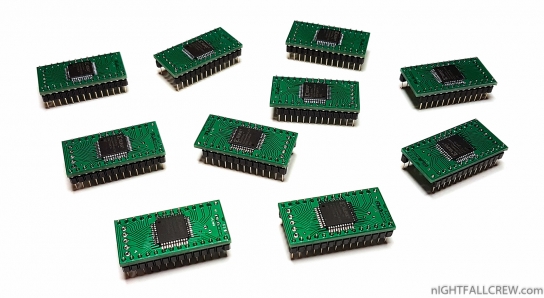
A new generation of PLA for the C64 is now available! PLAnkton is a new substitute for the C64 PLA U17 part no. 906114-01 or 251064-01.
A few years ago, a PLA based on the Xilinx XC9536 appeared in the Commodore community. This circuit is now out of production and has been for quite some time.
The new generation of CPLD which replaces this circuit is the XC9536XL which runs at a lower voltage and has more features built-in.
Fredric Blaholtz aka E5frog has created a new VHDL code for the XC9536XL which includes a sophisticated chain reaction delay to ensure full compatibility with all versions of the C64 and exploits the built-in slew rate control and low power mode of this modern IC. The result is a PLA that is fully compatible with all C64 boards except assy 250469 and all C64 cartridges including, FastLoad, Super Zaxxon, 1541 Ultimate I and II and consumes only 20mA – one fifth the power of an original Commodore PLA and produces absolutely no heat. It is equipped with gold plated pins to ensure the highest reliability and longevity.
This new PLA, when compared to the SuperPLA V3, proves to be 100% compatible with older boards Assy 326298 as well as all C64 cartridges including Epyx FastLoad, consumes one third the power and costs 25% less. Its also smaller and won’t cause physical conflict with the SID nearby on older boards.
Features and characteristics:
- Costs 35% less than the SuperPLA V3.
- Draws only 20mA – 1/5 the power of an original Commodore PLA – 1/3 the power of the Super PLA V3 or the same an a small green LED.
- Produces no discernable heat.
- Designed to produce electrical signals of EXACTLY the same voltages as a genuine Commodore PLA.
- 100% compatible with ALL C64 mainboards 326298, 250407, 250425, SX-64, 250466, 64 Reloaded (NOT compatible with board 250469)
- 100% compatible with ALL C64 cartridges including Epyx FastLoad, 1541 Ultimate I & II, Super Zaxxon, Easy Flash 1 and 3.
- Made only using currently available genuine Xilinx circuits purchased from an authorized distributor.
- Gold plated pins for best reliability and longevity.
Gallery:
source: melon64.com

What is DiagROM?
DiagROM is a diagnostic tool for the amiga computers.
And it is to be used on defective machines, trying to help no-boot situations etc.
You simply replace the Kickstart roms in the Amiga with the DiagROM. and when poweron. your Amiga will start a diagnostic software. It will try to dump info on the serialport (and actual menus etc aswell) while also trying on the screen.
Updatehistory:
- 2016-10-22: Fixed bugs in new Chipmemdetection that made it not detect any chipmem if there was missing/Broken chipmem in the beginning. Added errorhandling in the startprocess, so it can show on serialport if there was a exceptionerror. also will show colorcodes on screen. done some smaller bigfixes. Will bump versionnumber and this will be the stable version. It will take a while until next stable version is bumped. Need to do floppy, serial, paralell tests etc before that will happen. but you always have the daily version.
- 2016-10-12: New Chipmem detection now handles shadowram so it should stop detecting memory instead of giving false 2MB Chip. IF no Chipmem avaible and machine can detect fastmem (NON autoconfig. more or less only A3000/4000 motherboardmem) it will now start using fastmem only. (screen flickers in different colors instead of printing text, nullmodem only) Fixed addresserrorbugs at CIA and joystickport tests on machines with 68000CPU. also should have correct CIA timing on slow machines. IF fastmemshadowram is detected during memorytests, test will exit. MANUAL test have a option to disable that test.
- 2016-10-07: LONG time no updates. Familystuff. Anyway. decided to do a total redo of initcode especially chipmemdetection. Detection is slower, but progress is printed on serialport so you can see address checked and if failure (in the beginning of the detection) you will see what it wrote and what is read to help debugging of chipmemproblems. Screen should flicker in green while detecting. drawback is that some tests (cia and joyport tests) now generates an addresserror. Will have a look of that.
Download: DiagoROM v0.8 Stable (1092)
source: diagrom.com
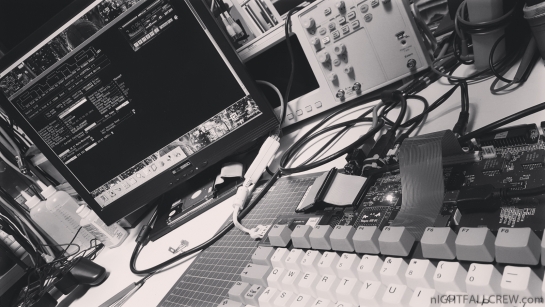
The Vampire 600 V2 is the newest and the fastest accelerator available for your Commodore Amiga 600. There is nothing on the market that can compete with its performance and price. It is intended to be used as an educational tool to allow users to be able to learn programming for the 68K series of CPU’s and see the capability of todays powerful FPGA’s.
This is not the final product as there will be constant impovements to the board and core and new programming instructions are being continually added.
Main Features:
- 128MB Fastmem RAM.
- Digital video output (HDMI).
- SD card for HDD storage.
- 64 bit core, full 32 bit compatibility.
- Directly update core from the Amiga without need for external programmer.
- FPU and 16 bit Audio is planned for future updates.
Gallery of the installation and testing:
Video Vampire A600 V2 Unboxing/Testing (sorry only in Italian language)
source: apollo-accelerators.com kipper2k.com
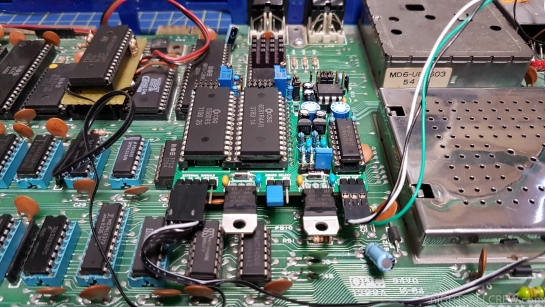
Assembly and Replacement of the old DualSID with the MixSID.
Unlike the DualSID i had to replace the two electrolytic capacitors (see picture) because the PCB of the MixSID is much more big and the two capacitors hinders the right installation of the PCB in the SID socket.
For the technical specifications of MixSID go here
Gallery:
source: henning-bekel.de
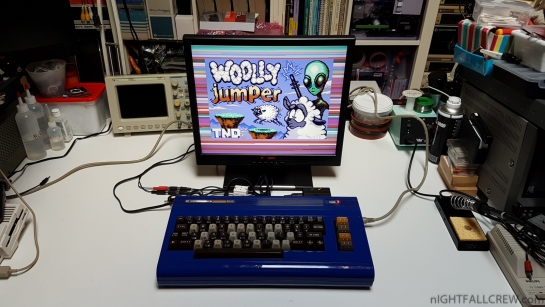
The ‘Ultimate II+’ is a storage solution for your Commodore C64/C128(D) home computer or in stand-alone mode for C16/Plus4/VIC-20 and so on.
This cartridge implements a ‘real’ 1541 Diskdrive for Commodore computers and with a simple press on one of the buttons, a menu will pop-up on the Commodore screen, allowing the user to view the USB storage content, and ‘mount’ .d64 or .g64 images into the Floppy Drive.
These are the most important differences from the previous version of the cartridge (1541 Ultimate-II)
- No more MicroSD! (… that needs to be pushed in with something sharp, could fall into the case, … etc)
- More USB ports (… one to compensate for the lost SD, and just one bonus: 3 in total)
- IEC connector moved (… further back to facilitate use on some C128 models)
- Integrated Ethernet (… no more need for an external USB2LAN adapter, and a smaller step to CS8900A compatibility)
- Dual Flash (… no more worry that a software bug or upgrade failure leads to a bricked device)
- Integrated Speaker (… who connects a speaker set to the audio jack for hearing drive sounds??)
- External power supply connector with auto-switch over circuit (… for stand alone mode, and to lower the demand on the power supply of the C64)
- Improved Audio (… audio codec, 24 bit/96 kHz*, for sampled sounds and SID emulation)
- Improved Tape connector (… no more custom board and able that snaps in on the bottom, but standard USB 3.0 cable)
- Improved power supply circuits (… for some reason they seemed to break down relatively often)
- Slightly bigger and faster FPGA, as to control the new features.
Gallery:
source: 1541ultimate.net facebook.com

The MixSID is a stereo SID board for the C64 that can be used with any combination of SID models on a wide range of C64 mainboards.
Features include an integrated stereo channel mixer, pragmatic stereo addressing scheme, flexible handling of io areas, onboard audio input, output and digiboost circuits, dedicated stereo output, full paddle compatibility and versatile digital control.
source: henning-bekel.de
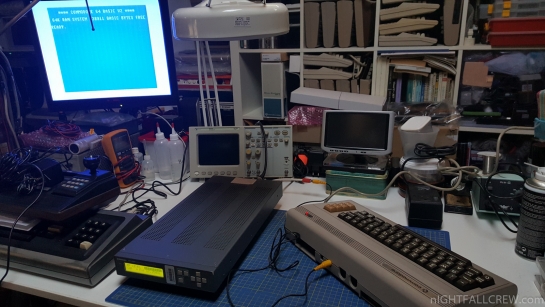
TekTronix DS1000G (NTSC version) Television Demodulator
The television demodulator can demodulate M/N standard television signals to baseband video and audio. In addition, the DS1001G provides the capability of recognizinga GCR signal and applying
correction to the baseband video output.
TheDS1001A/DS1001G covers the tuning range of 55.25 to 801.25MHz. The high performance of the conversion guarantees a measurement-quality signal after demodulation.
Gallery:
Download: TekTronix DS1000G Manual (1115)

…from the author website:
Since the end of 2015, it became clear that the “good old” 1541 Ultimate-II was at the end of its life cycle. Xilinx, the manufacturer of the most important chip of the cartridge, had started to increase the prices of the chip. Also the memory chip started to be harder to get and at higher cost. When the news came that the company that made the black plastic cases for the 1541 Ultimate-II had lost the injection mold tool, it became evident that the 1541 Ultimate-II would be no more.
I have given it some thought. What would be the best way to continue with this project? When the feelings of being upset about the lost injection tool had subsided, I realized that this may be the perfect moment for an upgrade. This is when set backs change into opportunity.
Since then, a lot of work, and I really mean A LOT OF WORK has been done to create a successor: the “Ultimate-II+”. Why not “III”, you may ask or think. Well, the foremost reason is the software. The install base of the “1541 Ultimate-II” is rather large (>3000 units), and I do not want to let my customers down that have just purchased a unit. This means that in case of new hardware, the same software should run on both the new board, as well as on the older board. So, the new board will offer similar functionality. You could see it just as an upgrade, not an entirely new product.

Although the “Ultimate-II+” is similar, there are also differences:
- No more MicroSD! (… that needs to be pushed in with something sharp, could fall into the case, … etc)
- More USB ports (… one to compensate for the lost SD, and just one bonus: 3 in total)
- IEC connector moved (… further back to facilitate use on some C128 models)
- Integrated Ethernet (… no more need for an external USB2LAN adapter, and a smaller step to CS8900A compatibility)
- Dual Flash (… no more worry that a software bug or upgrade failure leads to a bricked device)
- Integrated Speaker (… who connects a speaker set to the audio jack for hearing drive sounds??)
- External power supply connector with auto-switch over circuit (… for stand alone mode, and to lower the demand on the power supply of the C64)
- Improved Audio (… audio codec, 24 bit/96 kHz*, for sampled sounds and SID emulation)
- Improved Tape connector (… no more custom board and able that snaps in on the bottom, but standard USB 3.0 cable)
- Improved power supply circuits (… for some reason they seemed to break down relatively often)
- Slightly bigger and faster FPGA, as to control the new features
source: 1541ultimate.net
 The HxC Floppy Drive Emulator is a software and hardware system created by jfdn aka Jeff.
The HxC Floppy Drive Emulator is a software and hardware system created by jfdn aka Jeff.
The aim of this project is to replace the floppy disk drive by an electronic device emulating the floppy disk drive (list of supported Computer/Hardware).
There are two differents emulators:
- A USB version which allows to connect the floppy disk drive interface of the computer to a PC via a USB cable.
- A SDCARD version which allows to emulate floppy disks which images are stored in a SDCARD.
Release notes for the HxCFloppyEmulator software v2.1.4.0:
- New Loader : *.ANA AnaDisk file loader.
- New Loader : VFDDAT file loader.
- New Loader : Densei Sirius VFD DAT Loader.
- New Writer : *.DIM writer.
- New Writer : *.ADZ writer.
- New Writer : *.TRD Writer.
- New Loader : Atari ST *.STW Loader.
- New Writer : Atari ST *.STW Writer.
- New Writer : Atari ST *.ST Writer.
- New Writer : Atari ST *.STX Writer.
- STX Loader/Writer : Flakey bits mask support added, Loader/writer improved.
- SCP Loader/Writer : Loader/writer improved.
- D88 Loader : Gap3 setting corrected.
- Dos disk browser : More disks layouts.
- libhxcfe : New track support : AED6200P.
- XML format definitions : Mictrotan 65 TANDOS.
- Flux Stream Analyzer : Possible segmentation fault corrected.
- Flux Stream Analyzer : Input filtering reduced.
- Kryoflux Stream Loader (*XX.X.raw) / analyser : NFA over index support added.
- Track editor : Add & Remove track functions added.
- Track editor : RPM & Bitrate change functions added.
- Track editor : Insertion function added.
- Track editor : Negative offset support.
- Disk viewer : Image CRC32, library version and file name displayed.
- Disk viewer : Track(s) type displayed.
- Disk viewer : Cells density displayed.
- Progess bar added for the loaders/writers.
- SD/USB Emulator setting window : Advanced pinout settings added.
- Code sources fixes/changes for GCC, Clang and VS2015 x86 & x64 compilation support.
- And many more fixes and improvements..
Download:
source: hxc2001.free.fr lotharek.pl

Tynemouth Software PET microSD & PET ROM-RAM-Tester replacement boards
PET ROM-RAM-Tester:
This is a board which plugs into the 6502 CPU socket on something like a Commodore PET and can selectively replace the onboard ROM (it includes a test software) or RAM.
PET microSD:
Disk drive replacement for Commodore Pet range of computers, the 2001, 3000, 4000 and 8000 series. It also works with vic-20/c16/Plus4/c64/128*
*IEEE-488 adapter required.
You can buy these boards from here.
Packaging:
source: tynemouthsoftware.co.uk

UK1541 is a real time drive emulator with cycle-exact 6502 instructions execution and VIA’s emulation just by tiny MCU, LCP1114, Cortex M0, 48Mhz (0,84 DMIPS/Mhz).
Developed by Krzysztof Switajski aka Kisiel/ICON.
Features:
- LCD TFT Screen 2,2“ , 320 x 240, True Color.
- MSP430.
- LPC1114.
- Infra Red receiver, for remote control.
- CR2032 battery holder.
- Mini jack connector as replacement for IEC port.
- DB9 connector for joystick.
- User Port connector, for power and signals like 8-bit parallel aka burst.
- Two buttons , MENU and RESET.
Features for the latest Core Version (1.1.4.012015):
- Core 6502 running at 1Mhz with illegal opcodes – 16kB Flash ROM, multiple custom roms not available now
- 4KB Ram, from $0000 till $0fff
- VIA port and timers emulation
- SD card 1 – 8GB, FAT32, formatted in Windows.
- d64 35 / 40 track with read and write (beta testing)
- Update from standard SD card.
Gallery:
source: wiki.projekt64.filety.pl

Available on stock the new version of the V3 C64SD Princess by Manosoft. For more information please visit the Manosoft website.
source: manosoft.it
Jean-François DEL NERO (who’s behind the HxC SD Floppy Emulator) recently has released a version of the HxC emulator firmware that is compatible with the STM32 chip used in the Gotek floppy emulators.
This means that the great functionality of the HxC SD emulator is now available on cheaper and more widely available hardware.
The bootloader to convert the Gotek floppy drive in HxC compatible must be purchased on the website HXC 2001 by sending an email to Jean-François DEL NERO. The price of the bootloader is one-off 10 Euro per Gotek that you want to update. Future updates of the software are free and can be made from a USB stick
The HXC Usb (Gotek) firmware supports: 
Flashing the Gotek floppy emulator with HxC firmware:
source: hxc2001.com

 The HxC Floppy Drive Emulator is a software and hardware system created by jfdn aka Jeff.
The HxC Floppy Drive Emulator is a software and hardware system created by jfdn aka Jeff.




















Recent Comments